automatic transmission SUZUKI SWIFT 2000 1.G Transmission Service Service Manual
[x] Cancel search | Manufacturer: SUZUKI, Model Year: 2000, Model line: SWIFT, Model: SUZUKI SWIFT 2000 1.GPages: 447, PDF Size: 10.54 MB
Page 83 of 447
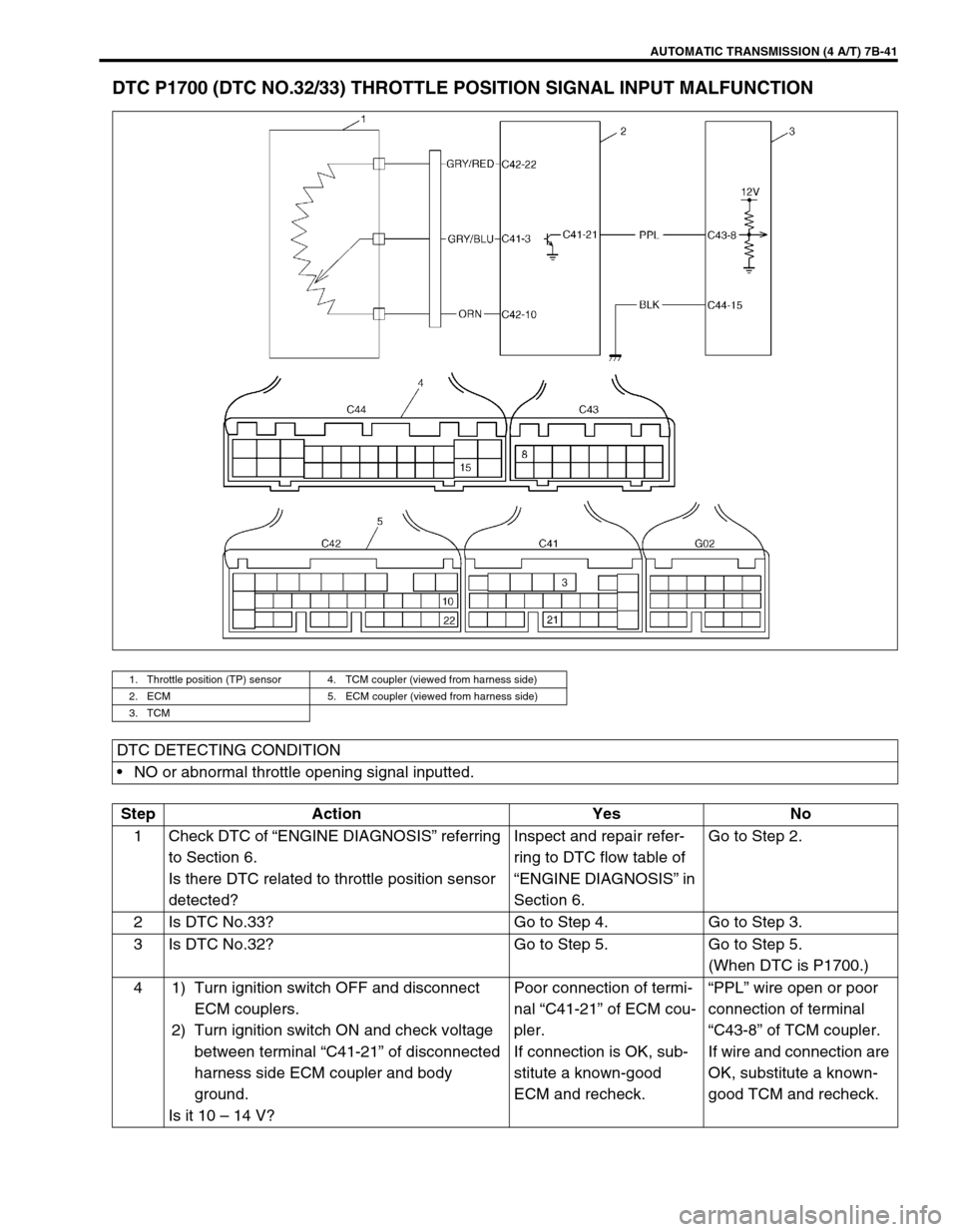
AUTOMATIC TRANSMISSION (4 A/T) 7B-41
DTC P1700 (DTC NO.32/33) THROTTLE POSITION SIGNAL INPUT MALFUNCTION
1. Throttle position (TP) sensor 4. TCM coupler (viewed from harness side)
2. ECM 5. ECM coupler (viewed from harness side)
3. TCM
DTC DETECTING CONDITION
NO or abnormal throttle opening signal inputted.
Step Action Yes No
1 Check DTC of “ENGINE DIAGNOSIS” referring
to Section 6.
Is there DTC related to throttle position sensor
detected?Inspect and repair refer-
ring to DTC flow table of
“ENGINE DIAGNOSIS” in
Section 6.Go to Step 2.
2 Is DTC No.33? Go to Step 4. Go to Step 3.
3 Is DTC No.32? Go to Step 5. Go to Step 5.
(When DTC is P1700.)
4 1) Turn ignition switch OFF and disconnect
ECM couplers.
2) Turn ignition switch ON and check voltage
between terminal “C41-21” of disconnected
harness side ECM coupler and body
ground.
Is it 10 – 14 V?Poor connection of termi-
nal “C41-21” of ECM cou-
pler.
If connection is OK, sub-
stitute a known-good
ECM and recheck.“PPL” wire open or poor
connection of terminal
“C43-8” of TCM coupler.
If wire and connection are
OK, substitute a known-
good TCM and recheck.
Page 84 of 447

7B-42 AUTOMATIC TRANSMISSION (4 A/T)
5 1) Turn ignition switch OFF and disconnect
ECM couplers.
2) Turn ignition switch ON and check voltage
between terminal “C41-21” of disconnected
harness side ECM coupler and body
ground.
Is it 10 – 14 V?Go to Step 7. Substitute a known-good
TCM and recheck.
6 1) Check for proper connection of terminal
“C41-21” of ECM coupler.
2) If OK, turn ignition switch OFF and discon-
nect ECM couplers.
3) Turn ignition switch ON and check voltage
between terminal “C41-21” of disconnected
harness side ECM coupler and body
ground.
Is it 10 – 14 V?Go to Step 7.“PPL” wire open or poor
connection of terminal
“C43-8” of TCM coupler.
If wire and connection are
OK, substitute a known-
good TCM and recheck.
7 1) Turn ignition switch OFF and disconnect
TCM couplers.
2) Check resistance between terminal “C43-8”
of disconnected harness side TCM coupler
and body ground.
Is it infinity?Intermittent trouble or
faulty ECM.
Check for intermittent
referring to “INTERMIT-
TENT AND POOR CON-
NECTION” in Section 0A.
If no trouble found, substi-
tute a known-good ECM
and recheck.“PPL” wire shorted to
ground. Step Action Yes No
Page 85 of 447
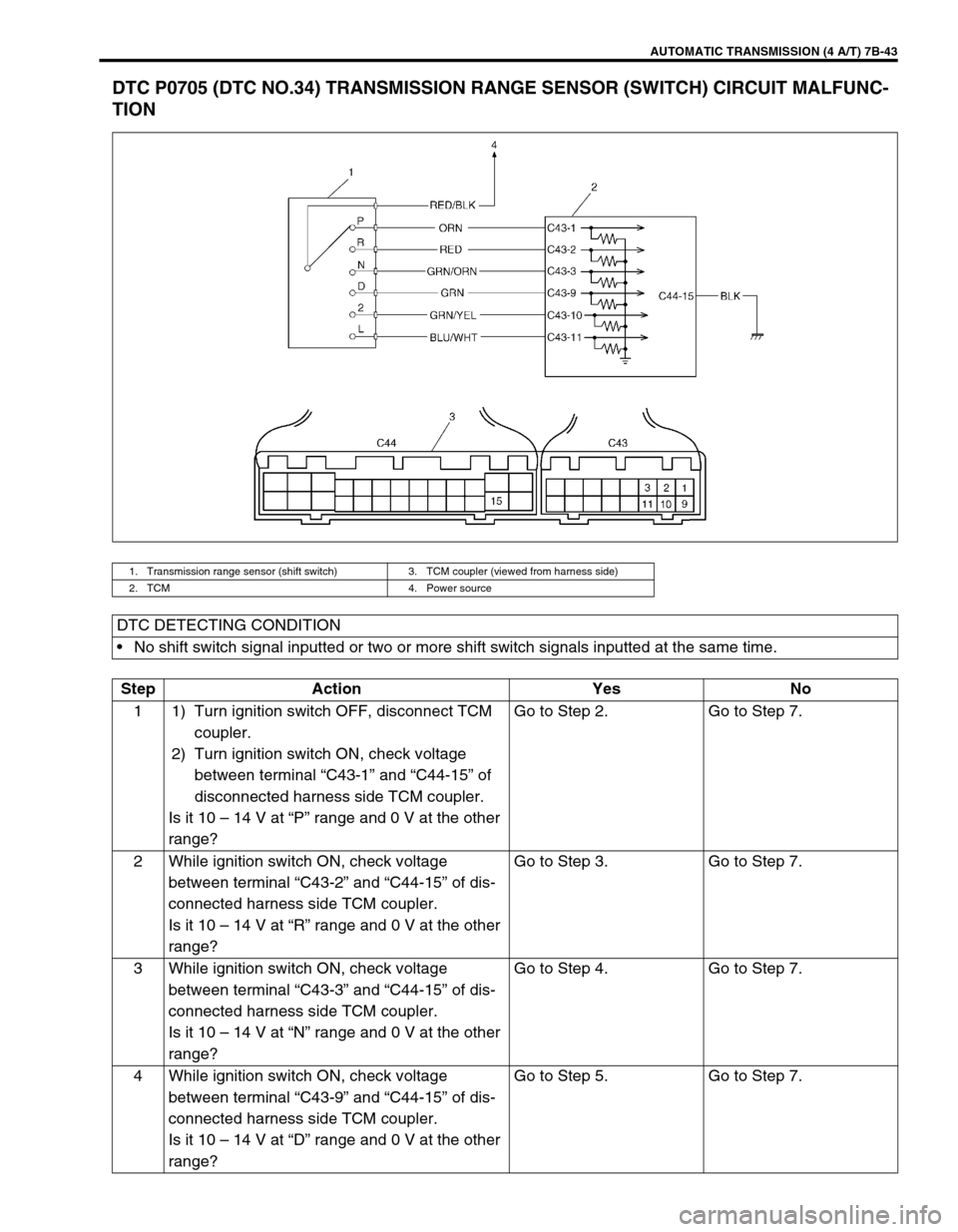
AUTOMATIC TRANSMISSION (4 A/T) 7B-43
DTC P0705 (DTC NO.34) TRANSMISSION RANGE SENSOR (SWITCH) CIRCUIT MALFUNC-
TION
1. Transmission range sensor (shift switch) 3. TCM coupler (viewed from harness side)
2. TCM 4. Power source
DTC DETECTING CONDITION
No shift switch signal inputted or two or more shift switch signals inputted at the same time.
Step Action Yes No
1 1) Turn ignition switch OFF, disconnect TCM
coupler.
2) Turn ignition switch ON, check voltage
between terminal “C43-1” and “C44-15” of
disconnected harness side TCM coupler.
Is it 10 – 14 V at “P” range and 0 V at the other
range?Go to Step 2. Go to Step 7.
2 While ignition switch ON, check voltage
between terminal “C43-2” and “C44-15” of dis-
connected harness side TCM coupler.
Is it 10 – 14 V at “R” range and 0 V at the other
range?Go to Step 3. Go to Step 7.
3 While ignition switch ON, check voltage
between terminal “C43-3” and “C44-15” of dis-
connected harness side TCM coupler.
Is it 10 – 14 V at “N” range and 0 V at the other
range?Go to Step 4. Go to Step 7.
4 While ignition switch ON, check voltage
between terminal “C43-9” and “C44-15” of dis-
connected harness side TCM coupler.
Is it 10 – 14 V at “D” range and 0 V at the other
range?Go to Step 5. Go to Step 7.
Page 86 of 447

7B-44 AUTOMATIC TRANSMISSION (4 A/T)
5 While ignition switch ON, check voltage
between terminal “C43-10” and “C44-15” of dis-
connected harness side TCM coupler.
Is it 10 – 14 V at “2” range and 0 V at the other
range?Go to Step 6. Go to Step 7.
6 While ignition switch ON, check voltage
between terminal “C43-11” and “C44-15” of dis-
connected harness side TCM coupler.
Is it 10 – 14 V at “L” range and 0 V at the other
range?Intermittent trouble or
faulty TCM.
Check for intermittent
trouble referring to
“INTERMITTENT AND
POOR CONNECTION”
in Section 0B.Go to Step 7.
7 Check transmission range sensor referring in
this section.
Is it OK?Transmission range sen-
sor wire shorted.
If wire harnesses are OK,
substitute a known-good
TCM and recheck.Replace transmission
range sensor. Step Action Yes No
Page 87 of 447
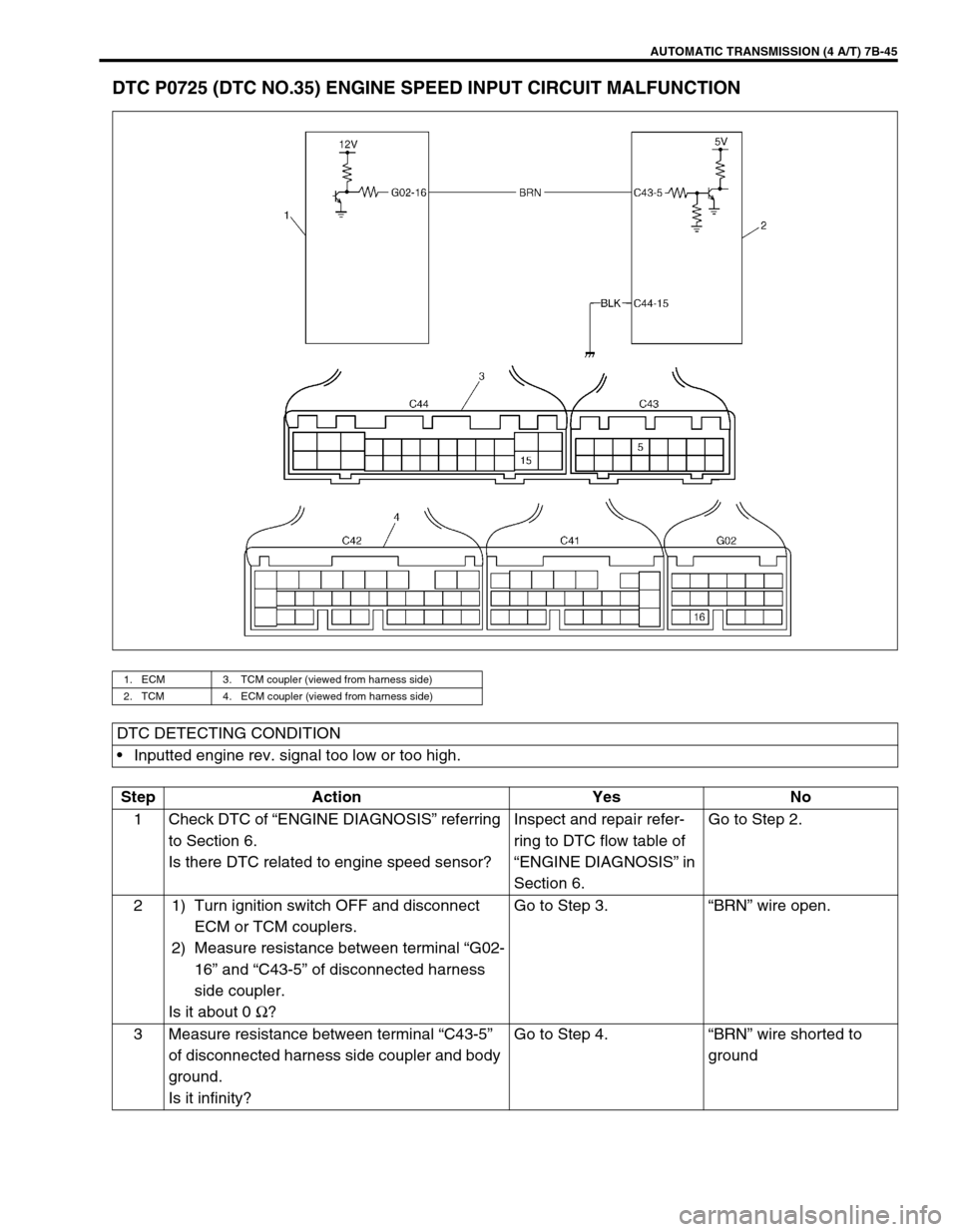
AUTOMATIC TRANSMISSION (4 A/T) 7B-45
DTC P0725 (DTC NO.35) ENGINE SPEED INPUT CIRCUIT MALFUNCTION
1. ECM 3. TCM coupler (viewed from harness side)
2. TCM 4. ECM coupler (viewed from harness side)
DTC DETECTING CONDITION
Inputted engine rev. signal too low or too high.
Step Action Yes No
1 Check DTC of “ENGINE DIAGNOSIS” referring
to Section 6.
Is there DTC related to engine speed sensor?Inspect and repair refer-
ring to DTC flow table of
“ENGINE DIAGNOSIS” in
Section 6.Go to Step 2.
2 1) Turn ignition switch OFF and disconnect
ECM or TCM couplers.
2) Measure resistance between terminal “G02-
16” and “C43-5” of disconnected harness
side coupler.
Is it about 0 Ω
?Go to Step 3.“BRN” wire open.
3 Measure resistance between terminal “C43-5”
of disconnected harness side coupler and body
ground.
Is it infinity?Go to Step 4.“BRN” wire shorted to
ground
Page 88 of 447

7B-46 AUTOMATIC TRANSMISSION (4 A/T)
4 1) Turn ignition switch OFF and connect ECM
couplers.
2) Turn ignition switch ON and measure volt-
age between terminal “C43-5” of discon-
nected harness side TCM coupler and body
ground.
Is it 10 – 14 V?Intermittent trouble or
faulty ECM or TCM.
Check for intermittent
referring to “INTERMIT-
TENT AND POOR CON-
NECTION” in Section 0A.
If no trouble found, substi-
tute a known-good ECM
or TCM and recheck.“BRN” wire is shorted to
power circuit or faulty
ECM.
If “BRN” wire is OK, sub-
stitute a known-good
ECM and recheck. Step Action Yes No
Page 89 of 447
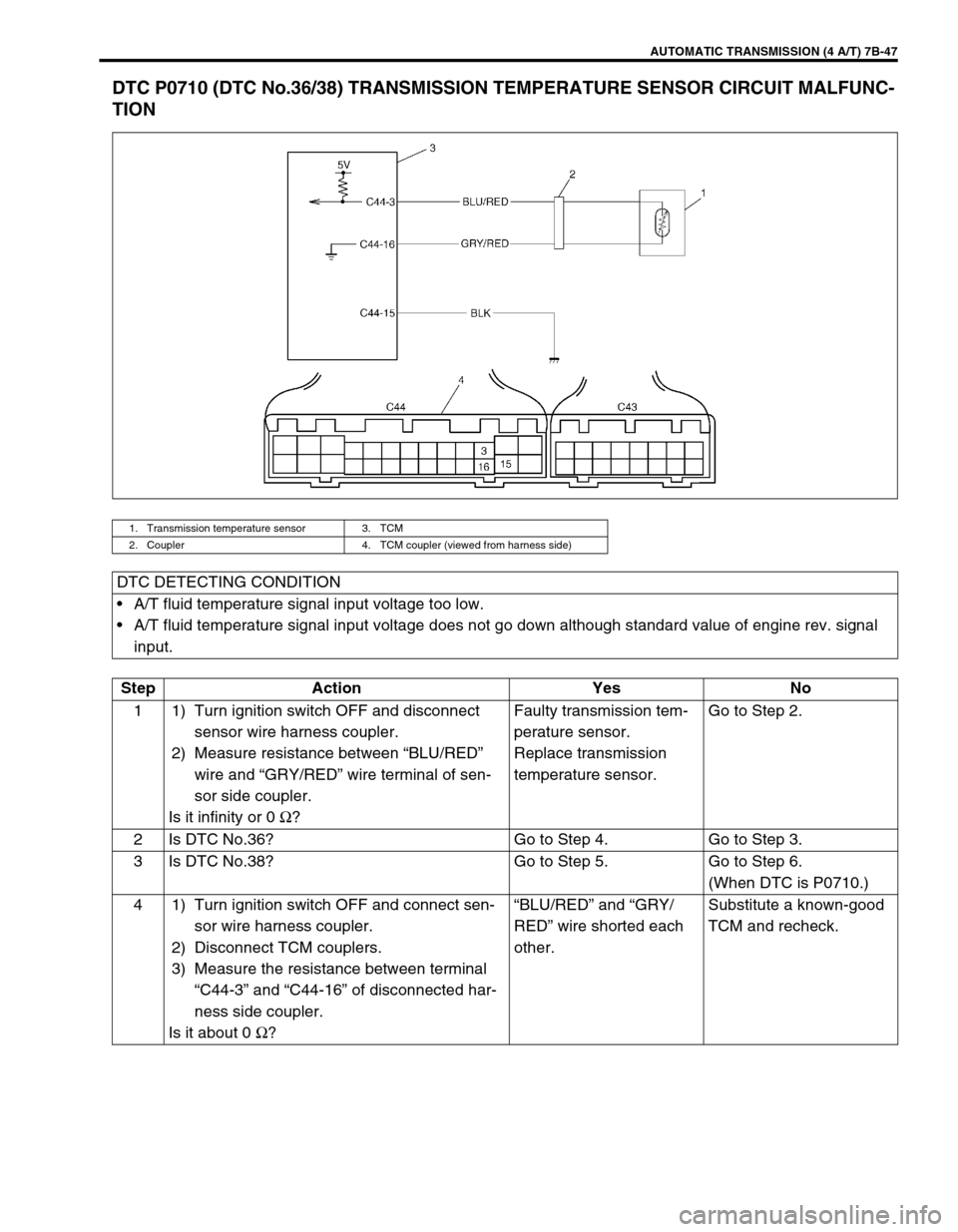
AUTOMATIC TRANSMISSION (4 A/T) 7B-47
DTC P0710 (DTC No.36/38) TRANSMISSION TEMPERATURE SENSOR CIRCUIT MALFUNC-
TION
1. Transmission temperature sensor 3. TCM
2. Coupler 4. TCM coupler (viewed from harness side)
DTC DETECTING CONDITION
A/T fluid temperature signal input voltage too low.
A/T fluid temperature signal input voltage does not go down although standard value of engine rev. signal
input.
Step Action Yes No
1 1) Turn ignition switch OFF and disconnect
sensor wire harness coupler.
2) Measure resistance between “BLU/RED”
wire and “GRY/RED” wire terminal of sen-
sor side coupler.
Is it infinity or 0 Ω
?Faulty transmission tem-
perature sensor.
Replace transmission
temperature sensor.Go to Step 2.
2 Is DTC No.36? Go to Step 4. Go to Step 3.
3 Is DTC No.38? Go to Step 5. Go to Step 6.
(When DTC is P0710.)
4 1) Turn ignition switch OFF and connect sen-
sor wire harness coupler.
2) Disconnect TCM couplers.
3) Measure the resistance between terminal
“C44-3” and “C44-16” of disconnected har-
ness side coupler.
Is it about 0 Ω
?“BLU/RED” and “GRY/
RED” wire shorted each
other.Substitute a known-good
TCM and recheck.
Page 90 of 447
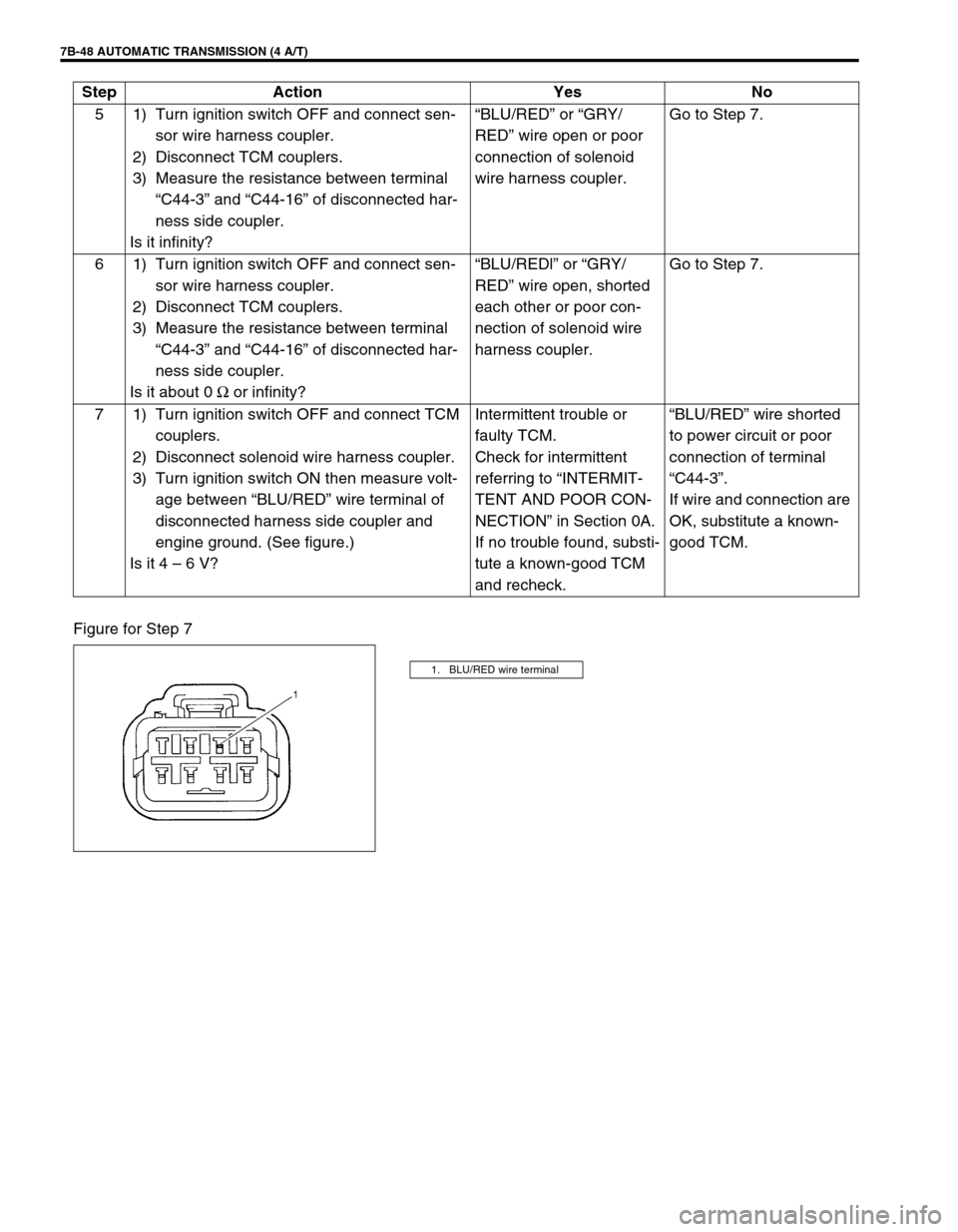
7B-48 AUTOMATIC TRANSMISSION (4 A/T)
Figure for Step 75 1) Turn ignition switch OFF and connect sen-
sor wire harness coupler.
2) Disconnect TCM couplers.
3) Measure the resistance between terminal
“C44-3” and “C44-16” of disconnected har-
ness side coupler.
Is it infinity?“BLU/RED” or “GRY/
RED” wire open or poor
connection of solenoid
wire harness coupler.Go to Step 7.
6 1) Turn ignition switch OFF and connect sen-
sor wire harness coupler.
2) Disconnect TCM couplers.
3) Measure the resistance between terminal
“C44-3” and “C44-16” of disconnected har-
ness side coupler.
Is it about 0 Ω
or infinity?“BLU/REDl” or “GRY/
RED” wire open, shorted
each other or poor con-
nection of solenoid wire
harness coupler.Go to Step 7.
7 1) Turn ignition switch OFF and connect TCM
couplers.
2) Disconnect solenoid wire harness coupler.
3) Turn ignition switch ON then measure volt-
age between “BLU/RED” wire terminal of
disconnected harness side coupler and
engine ground. (See figure.)
Is it 4 – 6 V?Intermittent trouble or
faulty TCM.
Check for intermittent
referring to “INTERMIT-
TENT AND POOR CON-
NECTION” in Section 0A.
If no trouble found, substi-
tute a known-good TCM
and recheck.“BLU/RED” wire shorted
to power circuit or poor
connection of terminal
“C44-3”.
If wire and connection are
OK, substitute a known-
good TCM. Step Action Yes No
1. BLU/RED wire terminal
Page 91 of 447

AUTOMATIC TRANSMISSION (4 A/T) 7B-49
DTC P0763 (DTC NO.43) SHIFT SOLENOID-C (NO.3) ELECTRICAL
DTC P0768 (DTC NO.45) SHIFT SOLENOID-B (NO.4) ELECTRICAL
DTC P0773 (DTC NO.48) SHIFT SOLENOID-E (NO.5) ELECTRICAL
1. Dropping resistor 4. Shift solenoid-D (No.4) 7. TCM coupler (viewed from harness side)
2. solenoid coupler 5. Shift solenoid-E (No.5)
3. Shift solenoid-C (No.3) 6. TCM
12V
C44-24
C44-13
C44-12
C44-11
C44-25
C44-26
C44-15
1
6
23
4
5
BRN/WHTGRY/BLU
RED/BLU
BLU/ORN
BRN
BLK/YEL
BRN/WHT
BLK/YEL
BRN
BLK
RED
YEL
BRN
7
DTC DETECTING CONDITION
Solenoid output voltage too high or too low differently from TCM order.
Step Action Yes No
1 1) Turn ignition switch OFF and disconnect sole-
noid coupler.
2) Measure resistance between terminal of sole-
noid coupler and transmission ground. (See
figure.)
Is it 2.5 – 3.5 Ω
?Go to Step 2.Solenoid lead wire open or
shorted to ground.
Malfunction of solenoid
valve.
2 1) Disconnect TCM couplers.
2) Measure resistance between terminal of dis-
connected body side solenoid coupler and
terminal “C44-11”, “C44-12” or “C44-13” of
disconnected harness side TCM coupler.
(See chart.)
Is it 6.5 – 8.5 Ω
?Go to Step 3. Inspect dropping resister refer-
ring to “DROPPING RESIS-
TOR” in this section.
If OK, circuit between TCM
and dropping resister or drop-
ping resister and solenoid cou-
pler open.
3 Check continuity between terminal “C44-24”,
“C44-25” or “C44-26” of disconnected TCM cou-
pler and terminal of disconnected body side sole-
noid coupler. (See chart.)
Is there continuity?Go to Step 4. Circuit between TCM and sole-
noid coupler open.
Page 92 of 447

7B-50 AUTOMATIC TRANSMISSION (4 A/T)
Chart for Step 2
Chart for Step 3
Chart for Step 5
Figure for Step 1 and 54 Check continuity between terminal of discon-
nected body side solenoid coupler and transmis-
sion ground with TCM, dropping resister and
solenoid couplers disconnected.
Is there continuity?Circuit between
TCM and transmis-
sion shorted to
ground.Go to Step 5.
5 Check continuity between terminal of discon-
nected body side dropping resistor coupler and
transmission ground. (See chart.)
Is there continuity?Circuit between
TCM and dropping
resister is shorted
to ground.Intermittent trouble or faulty
TCM.
Check for intermittent referring
to “INTERMITTENT AND
POOR CONNECTION” in Sec-
tion 0A. If no trouble found,
substitute a known-good TCM
and recheck.
Solenoid TCM terminal No.Solenoid coupler lead wire color
(body side)
C (No.3) C44-11 BRN
D (No.4) C44-12 BLK/YEL
E (No.5) C44-13 BRN/WHT
Solenoid TCM terminal No.Solenoid coupler lead wire color
(body side)
C (No.3) C44-24 BRN
D (No.4) C44-25 BLK/YEL
E (No.5) C44-26 BRN/WHT
Solenoid TCM terminal No.Dropping resistor lead wire color
(body side)
C (No.3) C44-11 GRY/BLU
D (No.4) C44-12 RED/BLU
E (No.5) C44-13 BLU/ORN
1. Solenoid coupler
2. Terminal for shift solenoid-C (No.3)
3. Terminal for shift solenoid-D (No.4)
4. Terminal for shift solenoid-E (No.5)
5. Transmission range sensor (Shift switch)
6. Dropping resistor terminal for shift solenoid-C (No.3)
7. Dropping resistor terminal for shift solenoid-D (No.4)
8. Dropping resistor terminal for shift solenoid-E (No.5)
9. Dropping resistor coupler
Step Action Yes No